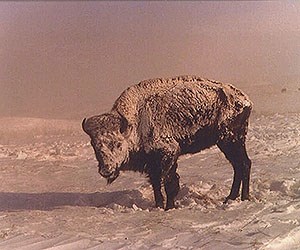Last updated: October 16, 2018
Article
Bison Bellows: The winter survivor

Photo courtesy of Glenn Plumb and The Nature Conservancy.
Every year when mid-winter arrives, snow can blanket the northern Great Plains, temperatures can drop well below zero, and the winds can howl unmercifully, and yet bison remain alive and well on the hostile landscape. Indeed, bison have evolved digestive, physiological, and behavioral strategies that allow them to survive some of the harshest weather in North America.
During the cold winter season, bison develop thick, woolly coats that help protect them from freezing temperatures and harsh winds. It is said that a bison's winter coat is so thick and provides insulation so effective that when snow accumulates on its coat, it will not melt from the heat of the bison's skin. Their skin also thickens in response to cold temperatures and fatty deposits appear to insulate the animal. This is important because during winter storms, bison will actually turn toward the storm, hunker down, and wait for it to pass. With thick coats and creating a low profile, bison can survive the same storm that would kill many domestic livestock. Bison also have the ability use their large head and massive neck and shoulder muscles as snow plows to forage in snow as deep as four feet!
But what is perhaps most impressive is how eating grass allows them to have enough energy to survive the winters. Think about it: in winter, a big, hearty stew full of meat and potatoes sounds appetizing to many people. We crave those large, filling meals to keep us warm in the middle of winter. Could you imagine eating only stalks of celery after skiing or working in zero degree weather all day? Well that is almost exactly what bison do, and they have adapted to efficiently find nourishment from low quality forage that allows them to battle blizzards, -40 degree temperatures, and 50 mph winds.
Under cold stress, bison have developed the adaptation to minimize nutritional needs and slow their metabolism to conserve energy. Metabolism is a term used to describe the process by which our bodies convert food into energy. People say bison during the winter are time minimizers rather than energy maximizers. In other words, bison cannot merely eat more food and more often to compensate for the low nutritional forage they eat. Instead, they slow down their metabolisms, the amount of time they spending foraging, and the amount of . food they consume in order to conserve energy. Bison also have the ability to generate internal body heat through digestion. Forage is retained longer in their gut — due to the increase of indigestible plant material found in the winter — which allows them to eat less but still receive the nutrition they require. Without these adaptations, surviving the freezing temperatures and blizzard storms would not be possible.
Did you know?
Pregnant female bison lose a substantial amount of body mass over the winter. Pregnant bison will mobilize fat reserves during late gestation periods to meet increasing nutritional demands. Often this is a tradeoff and immune functioning decreases. If reproductive demands are prioritized over immune defense, then nutritional resources are allocated to fetal growth, making female bison more susceptible to diseases and extreme weight loss during the winter.
